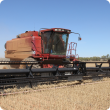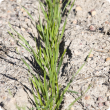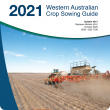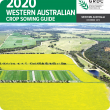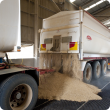Crops
The Department of Primary Industries and Regional Development continues to support the growth and international competitiveness of all crop industries in Western Australia.
With a 2400 kilometre span from its tropical north to its temperate south, WA supports a broad range of cropping industries from rain-fed winter cereals through to irrigated horticultural crops.
In the 2012/13 year the WA cropping industries exported a total of $3.9 billion which comprised: $3.1 billion of cereals, $859 million of pulses, pastures and oilseeds, $142 million of horticultural crops. The major contributors to these exports were wheat ($2.7 billion), canola ($756 million), barley ($377 million), lupins ($42 million), carrots at $48 million, oats ($12 million), and strawberries at $5.5 million.
Filter by search
Filter by topic
- (-) Remove Grains filter Grains
- (-) Remove Canola filter Canola
- (-) Remove Wheat filter Wheat
- Barley (13) Apply Barley filter
- Oats (8) Apply Oats filter
- Lupins (8) Apply Lupins filter
- Pulses (7) Apply Pulses filter
- Pests, weeds & diseases (6) Apply Pests, weeds & diseases filter
- Grains research & development (6) Apply Grains research & development filter
- Climate, land & water (5) Apply Climate, land & water filter
- Soils (4) Apply Soils filter
- Production & postharvest (4) Apply Production & postharvest filter
- Diseases (4) Apply Diseases filter
- Pests (4) Apply Pests filter
- Crop diseases (4) Apply Crop diseases filter
- Managing soils (3) Apply Managing soils filter
- Weeds (3) Apply Weeds filter
- Crop weeds (3) Apply Crop weeds filter
- Climate & weather (3) Apply Climate & weather filter
- Pest insects (2) Apply Pest insects filter
- Pastures (2) Apply Pastures filter
- Sowing (2) Apply Sowing filter
- Storage (2) Apply Storage filter
- Postharvest (2) Apply Postharvest filter
- Mechanical, physical and cultural (2) Apply Mechanical, physical and cultural filter
- Nematodes (2) Apply Nematodes filter
- Food, export & investment (2) Apply Food, export & investment filter
- Control methods (2) Apply Control methods filter
- Investment attraction (2) Apply Investment attraction filter
- Frost (2) Apply Frost filter
- Plant biosecurity (1) Apply Plant biosecurity filter
- Livestock management (1) Apply Livestock management filter
- Soil acidity (1) Apply Soil acidity filter
- Pasture management (1) Apply Pasture management filter
- Viruses & virus-like (1) Apply Viruses & virus-like filter
- Water repellence (1) Apply Water repellence filter
- Livestock & animals (1) Apply Livestock & animals filter
- Soil nutrients (1) Apply Soil nutrients filter
- Soil compaction (1) Apply Soil compaction filter
- Fungi (1) Apply Fungi filter
- Biosecurity & quarantine (1) Apply Biosecurity & quarantine filter
- Biosecurity (1) Apply Biosecurity filter
- Bacteria (1) Apply Bacteria filter
- Chemicals (1) Apply Chemicals filter
- Emergency response (1) Apply Emergency response filter
- Fungicides (1) Apply Fungicides filter
- Feeding & nutrition (1) Apply Feeding & nutrition filter
- Grains Research & Development (1) Apply Grains Research & Development filter






